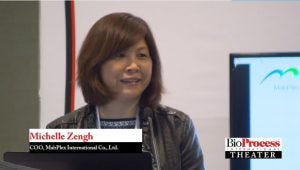- Sponsored Content
- Emerging Therapeutics
The Development of a Next Generation Antibody–Drug Conjugate (ADC)The Development of a Next Generation Antibody–Drug Conjugate (ADC)
August 23, 2018
Sponsored by MabPlex
 Michelle Zengh, chief operating officer, MabPlex International Company Ltd.
Michelle Zengh, chief operating officer, MabPlex International Company Ltd.
MabPlex presents a complete solution from gene cloning to antibody–drug conjugate (ADC) fill–finish with a timeline from gene cloning to an investigational new drug application (IND) in 22 months. The company has facilities in San Diego and in China. It can perform cloning and high-yield stable cell-line development, process development and scale-up, CGMP quality and kilogram-scale monoclonal antibody (MAb) and payload manufacturing, large-scale conjugation (150–500 L), large-scale purification, formulation, and fill–finish.
Based on the target disease and cell type, MabPlex and its clients can choose from a number of different linker–toxin combinations and use different conjugation technologies. This creates a substantial set of ADCs that clients can screen to determine the most effective ADC for their needs. The company has experience with traditional cysteine conjugations using maleimide, lysine conjugation, nonnatural amino acids, enzymatic methods, and several client-patented site-specific conjugation methods. Drawbacks of the technology include heterogeneous results from traditional techniques, the (long) length of time it requires (for example, site-directed mutagenesis), and costliness of scale-up.
Because traditional maleimide conjugation can create a large variation in the drug-to-antibody ratio (DAR) (DAR6 and DAR8 often lead to toxicity whereas DAR2 and DAR4 are usually most effective), MabPlex set out to create a new conjugation method while also preventing site-directed mutagenesis. Traditional cysteine conjugation can create instability of an ADC molecule. MabPlex’s new thiol-covalent technique creates more stability through covalent bonding, and the sites allow for maximal homogeneous DAR4 (with the DAR4 ratio above 85%). Testing showed that thiol-covalent conjugated ADCs were more stable in blood circulation than other ADCs and were more effective at inhibiting tumors in mice.
MabPlex capabilities also include working with small-scale linker and toxin synthesis, small-scale conjugations, and GMP synthesis of linker and toxin. It can do everything as a “one shop stop” in both small- and large-scale facilities. More than 90 ADCs have been delivered to clients since 2015.
MabPlex has extensive capabilities in multiple conjugation technologies; created a scalable next-generation technology that eliminates heterogeneity without the cost, royalties, or time of site-directed mutagenesis. It provides ADC services from protein sequence to commercial scale, including GMP linker and toxin synthesis. Thiol-Covalent conjugation technology provides DAR4 at 85–90%. Finally, when your are ready to file an IND, the company will triple-file for you in Australia, the United States, and China.
Watch Online
Just fill out this form to watch the full presentation.
You May Also Like





